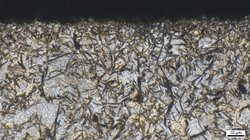Influence of Nanoscale Precipitation States in the Surface Layer on the Gear Load Capacity by Thermochemical Heat Treatments
Research Topic
| Short Title | CarbidRAnd |
| End of Project | 2023 |
| Funding | FVA-Nr. 513/IV, IGF-Nr. 20054 N Federal Ministry for Economic Affairs and Climate Action, BMWK |
| Project Partner | Leibniz-Institut für Werkstofforientierte Technologien, IWT |
| Contact | Division Load Carrying Capacity Cylindrical Gears |
Project Description
In this project, the reproducible adjustability of surface layer conditions with varying contents of retained austenite and precipitation states of varying degrees as well as the strength properties resulting from the multiphase microstructure were investigated. The adjustment of the variants was carried out using various parameters from the field of heat treatment. In addition, a steel grade with a modified alloying system was considered.
Based on previous knowledge on the process design of such surface layers, several variants were adjusted by a case hardening process using carbonitriding. In addition, low-pressure carburizing was used. Since the heat treatment variants investigated in this project lie far outside the usual process windows, framework conditions for reproducible production of these surface layer are listed.
Quantitative characterization of these states remains a key component with respect to correlation with strength properties. By using synchrotron radiation, a direct correlation of the phase fractions with the element contents over the entire surface layer range is possible, thus providing new knowledge in this project. However, access to this measurement is severely limited and thus cannot be applied to a wide range of applications.
Testing of the heat treatment variants by means of rotating bending tests as well as torsion tests was able to show the potential of the surface layers with regard to an increase in strength. Further analysis of the processes during testing revealed not only changes in the retained austenite content but also corresponding changes in the residual stresses and the half-value widths in the present phases.
In the experimental investigations on gear load carrying capacity, the influence of various pronounced carbide or carbonitride precipitations on the resulting component service life was determined extensively.
